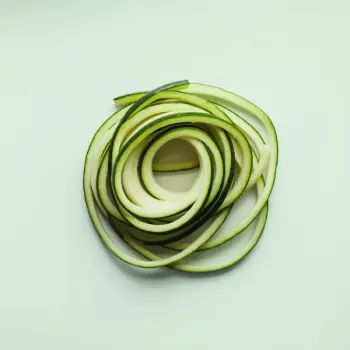Shirataki Noodles and Zucchini Noodles are healthy, low-carb alternatives to traditional pasta. Shirataki noodles, made from the konjac yam, are ideal for absorbing flavors in dishes. Zucchini noodles, made by spiralizing zucchini, add a fresh and nutritious element to meals.

Shirataki noodles, often known as 'miracle noodles,' are translucent, gelatinous traditional Japanese noodles made from the konjac yam. They are low in calories and carbohydrates, and are a popular choice for those on ketogenic, gluten-free, or low-carb diets.

Zucchini noodles, or 'zoodles,' are strands of zucchini that have been spiralized or cut into noodle-like shapes. They offer a fresh, plant-based alternative to traditional pasta, are rich in vitamins, and are suitable for a variety of dietary preferences, including vegan and paleo diets.
Shirataki noodles are almost zero-calorie and carbohydrate, with a chewy texture and a neutral taste that absorbs flavors well. Zucchini noodles, on the other hand, have a slightly sweet taste, a more delicate texture, and contain more vitamins and minerals than shirataki. They also contribute to your daily vegetable intake.

Your ultimate Recipe Box, Meal Planner, and Cooking Class all in one
Ideal for dishes like ramen, stir-fries, and pho, where they absorb the rich flavors of broths and sauces. Their texture holds up well to the heat and complements the savory elements of Asian cuisine. Best suited for lighter dishes such as cold noodle salads or quick sautés. Zoodles add a fresh, vibrant element and work well with tangy dressings and crisp vegetables.
Can be used in place of traditional pasta in dishes like spaghetti Bolognese or fettuccine Alfredo, offering a low-calorie option that lets the bold Italian flavors shine. Perfect for pesto pasta or primavera, where their freshness complements the bright flavors of herbs and fresh vegetables. They offer a lighter, more delicate base for these Italian classics.
Not typically recommended for casseroles and bakes due to their texture, which doesn't mimic traditional pasta well in these dishes. Zoodles can be baked into casseroles or lasagna, offering a nutritious, low-carb layer that complements cheese and sauce. Be mindful of their water content, which can be reduced by pre-salting and draining.
Shirataki noodles are very low in calories and carbohydrates, making them suitable for keto and low-carb diets. Zucchini noodles offer a range of nutrients including vitamin C, potassium, and fiber.
| Nutrient | Zucchini Noodles ( per 100g ) | Shirataki Noodles ( per 100g ) |
|---|---|---|
| Fat | 0.4g | 0g |
| Fiber | 1.1g | 3g |
| Sodium | 8mg | 0mg |
| Protein | 1.2g | 0g |
| Calories | 20 | 10 |
| Carbohydrates | 3.9g | 3g |
Both options are low in calories and carbohydrates, making them suitable for weight loss. Shirataki noodles are almost zero-calorie, while zucchini noodles provide additional nutrients.
Not all dishes are ideal for both. Shirataki noodles are more suited for dishes that require a noodle to absorb flavors, while zucchini noodles are great for fresher, lighter dishes.
Shirataki noodles have a very neutral taste, making them a versatile base for absorbing the flavors of the sauces and seasonings they are cooked with.
To prevent sogginess, you can salt the zoodles and let them sit to draw out moisture, pat them dry, or cook them for a short time to maintain their crispness.
Yes, Shirataki noodles are made from konjac yam and are naturally gluten-free, making them suitable for those with celiac disease or gluten intolerance.